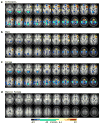Females and males are highly similar in language performance and cortical activation patterns during verb generation
- PMID: 21676387
- PMCID: PMC3179789
- DOI: 10.1016/j.cortex.2011.05.014
Females and males are highly similar in language performance and cortical activation patterns during verb generation
Abstract
Objective: To test the existence of sex differences in cortical activation during verb generation when performance is controlled for.
Methods: Twenty male and 20 female healthy adults underwent functional magnetic resonance imaging (fMRI) using a covert block-design verb generation task (BD-VGT) and its event-related version (ER-VGT) that allowed for intra-scanner recordings of overt responses. Task-specific activations were determined using the following contrasts: BD-VGT covert generation>finger-tapping; ER-VGT overt generation>repetition; ER-VGT overt>covert generation. Lateral cortical regions activated during each contrast were used for calculating language lateralization index scores. Voxelwise regressions were used to determine sex differences in activation, with and without controlling for performance. Each brain region showing male/female activation differences for ER-VGT overt generation>repetition (isolating noun-verb association) was defined as a region of interest (ROI). For each subject, the signal change in each ROI was extracted, and the association between ER-VGT activation related to noun-verb association and performance was assessed separately for each sex.
Results: Males and females performed similarly on language assessments, had similar patterns of language lateralization, and exhibited similar activation patterns for each fMRI task contrast. Regression analysis controlling for overt intra-scanner performance either abolished (BD-VGT) or reduced (ER-VGT) the observed differences in activation between sexes. The main difference between sexes occurred during ER-VGT processing of noun-verb associations, where males showed greater activation than females in the right middle/superior frontal gyrus (MFG/SFG) and the right caudate/anterior cingulate gyrus (aCG) after controlling for performance. Better verb generation performance was associated with increased right caudate/aCG activation in males and with increased right MFG/SFG activation in females.
Conclusions: Males and females exhibit similar activation patterns during verb generation fMRI, and controlling for intra-scanner performance reduces or even abolishes sex differences in language-related activation. These results suggest that previous findings of sex differences in neuroimaging studies that did not control for task performance may reflect false positives.
Copyright © 2011 Elsevier Srl. All rights reserved.
Figures




References
-
- Badre D, Poldrack RA, Pare-Blagoev EJ, Insler RZ, Wagner AD. Dissociable controlled retrieval and generalized selection mechanisms in ventrolateral prefrontal cortex. Neuron. 2005;47 (6):907–918. - PubMed
-
- Barch DM, Braver TS, Sabb FW, Noll DC. Anterior cingulate and the monitoring of response conflict: evidence from an fMRI study of overt verb generation. Journal of Cognitive Neuroscience. 2000;12 (2):298–309. - PubMed
-
- Baxter LC, Saykin AJ, Flashman LA, Johnson SC, Guerin SJ, Babcock DR, Wishart HA. Sex differences in semantic language processing: a functional MRI study. Brain and Language. 2003;84 (2):264–272. - PubMed
Publication types
MeSH terms
Grants and funding
LinkOut - more resources
Full Text Sources

